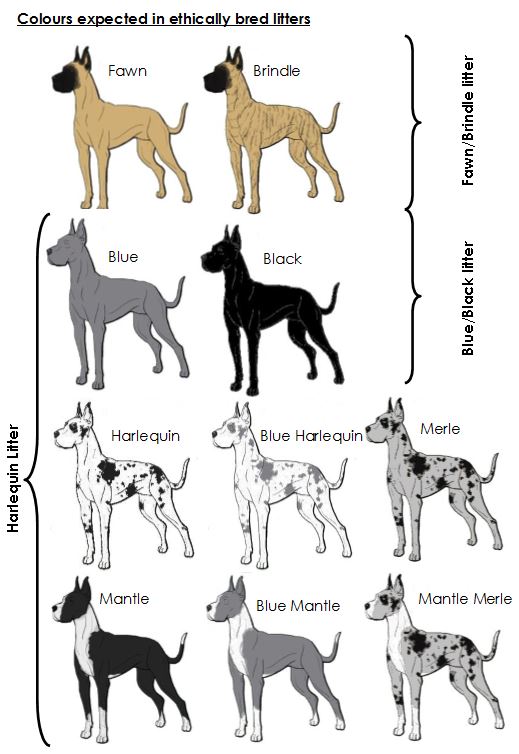Colours expected in an ethically bred litter.
If you read the Great Dane Standard, there are 6 official colours (we use the UK Standard). These colours are the ones people can show and what they breed for. They are:
- Black (solid black dog with very little white allowed on toes and chest)
- Blue (solid grey dog with very little white allowed on toes and chest)
- Fawn (golden dog with black mask on face)
- Brindle (golden dog with black mask and tiger-like stipes on body)
- Harlequin (white dog with torn black patches or torn blue patches)
- Mantle (black dog with white muzzle, neck, chest, legs and tail tip)
These are the show colours. They are, however, not the only colours that can arise from ethical breeding. In harlequin breeding another colour will be produced, Merle. This is a lovely mottled grey base with torn black or blue patches on it. Many people believe there are health issues related to a merle. This is not true. Not any more than with any of the other colours.
Merle is an ethical colour, a true colour of the Great Dane. Without it there can be no harlequin, since a harlequin is merely a merle with an added (H) gene that “bleaches” the mottled grey white to make the white background of the harlequin. In other words, if merle carries health defects, then so does harlequin.
The problem is not the colour merle. The trouble is the double merle. These dogs have sensory defects (blindness and deafness). Therefore ethical breeders refrain from breeding two harlequins or two merles or a harlequin and merle. All of the above will result in a portion of the litter being double merles. They are usually very white or white with merle patches on them.
In a blue harlequin litter there could also be blue mantles as mantle is part and parcel of the harlequin breeding colour package. The merles from that litter could be lighter grey with torn blue patches.

Why do we stick to the traditional breed colours?
In the Great Dane breed we traditionally have 3 separate colour families, Blue/Black, Fawn/Brindle and Harlequin/Black & White. Many people now ask why we are so restrictive with the colour and why can’t we breed “colour blind” and allow all colours. The reason might come as a shock to many. The restrictions are there to PRESERVE our colours, to stop them from disappearing.
In colour genetics you have dominant colours and recessive colours. When a dominant and a recessive meet, only the dominant shows. In other words, if you want a dog to have a recessive colour, you need both parents to carry it to ensure that at least some of the pups show that colour. To have dogs in recessive colours, you have to selectively BREED for those colours.
In the Great Dane colour family, Harlequin, Merle and Black are dominant and blue, fawn and brindle are recessive. If we choose to breed colour blind for a decade or two, the only colours left to see will be Merle with little white, heavily marked Harlequin and mismarked blacks. We will effectively REDUCE the number of colours in our breed.
If this is allowed, in 50 years’ time people will want the historical blue or fawn or brindle Great Dane and will start to breed for it selectively. Basically putting us right back to where the breed founders were more than 200 years ago! Why do that to ourselves?
The rules regarding colour are not there to restrict colours, as it might seem at first glance. Once you bring in basic colour genetics, you will understand that those restrictions are there to prevent our recessive colours from disappearing.
